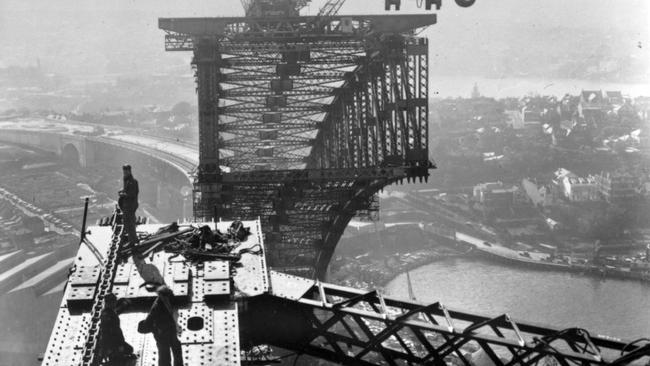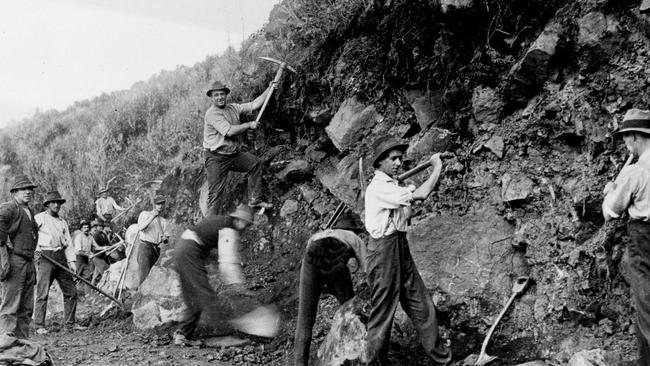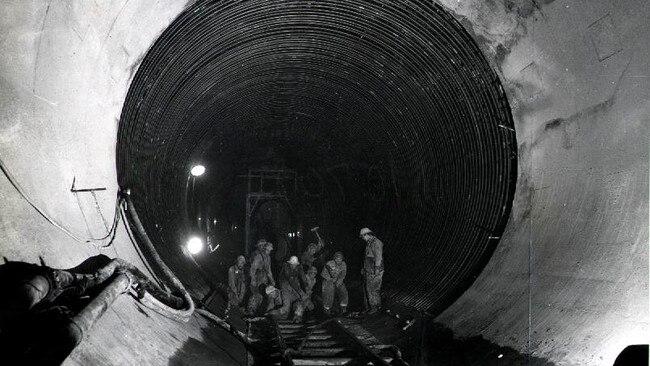Silver linings: what will be the legacy of our hard times?
It took a crisis to realise some of Australia’s grandest ambitions. What will be the legacy of COVID-19?

One of the most shocking photo shoots in Australia’s history occurred in 1930s Melbourne in squalid neighbourhoods where multi- million-dollar houses now stand. A Methodist accountant, Frederick Oswald Barnett, had become a frequent visitor to the ramshackle laneways of Fitzroy, Collingwood and Richmond since his first visit in the early 1920s, and he documented a tragic reality that would shame the city into action. The Great Depression had exacerbated the living conditions of Melbourne’s poor, who lived in Dickensian conditions so appalling few could believe it was Australia. Families of 10 or more huddled in leaky, crumbling brick or corrugated iron shacks with no sewerage and often just one shared outdoors tap. Barnett shone a glaring light on the slums and became a fierce campaigner for proper housing. He dragged the premier, Albert Dunstan, along to see the squalor for himself. Dunstan said afterwards he couldn’t sleep for days.
As the Great Depression subsided a campaign for permanent improvements to shocking living conditions gathered momentum, leading to the Housing Commission of Victoria in 1938. It set in motion a resolve to demolish the shameful slums and create affordable public housing for the city’s vulnerable. Dark as the Great Depression was, a silver lining flickered in the shadows.
In Sydney, while Barnett was fighting for proper housing for the poor, something much more eye-catching was under construction. A bridge between the north and south shores of Port Jackson had been talked about since settlement, but it took a major economic disruption for it to be realised. Sydney Harbour Bridge – the most ambitious infrastructure ever attempted in Australia – was built in the years following World War I and completed during the darkest days of the Depression, and became known as the state’s Iron Lung. NSW premier Jack Lang rebelled against the federal government’s policy of not defaulting on loan repayments to Britain in favour of expanding public works schemes. It gave NSW a deficit larger than every other state put together, but it also gave it the bridge. When Lang cut the ribbon in 1932, unemployment in Australia had topped 30 per cent but the celebrations were immense. The bridge instantly became a symbol of Australia’s growing independence, modernisation and maturity. It was a remarkable landmark project, a nation-building achievement that owes its existence to times of unthinkable hardship.
We’ve seen it time and time again. After bust comes boom. Major disruptions and economic calamities have historically opened the doors for positive change and left lasting imprints on our built landscapes. Against the backdrop of COVID-19 we’re seeing it again, with the rediscovery of the local neighbourhood counterpointing the tragedies of unemployment and its associated issues. We’ve started once again looking for a legacy, wondering how our country might visibly change for the better, seeking out that light in the gloom.

Hard times have always driven us to create epic structures that fill the soul, as well as the wallets of those who build them. Looking back, we wonder how we ever did without them.Victoria’s Great Ocean Road was first conceived as a World War I memorial and gave about 3000 returned servicemen work from the time it started in 1919 to its completion in 1932. The University of Melbourne’s chair of architecture, Professor Philip Goad, describes the road as one of our country’s great nation-building projects. “After the war there was an enormous number of soldiers returning and finding themselves out of work. So the project gave them work as well as creating arguably the largest war memorial in the world.”
Goad says the modernisation of Australia after World War II forever changed our built landscape, exemplified largely in the way we built houses and pushed out into the suburbs. We had large families and craved more space. The kitchen became the centre of the house, the centre of family life. Home entertainment became a thing. We built swimming pools, had dinner parties; our homes opened out to a patio and attractive yards. The Space Age was here and our home appliances looked positively galactic. We whizzed around in Holdens sporting rocket fins and parked them in carports to show off to the neighbours. As Goad puts it, “We went from being essentially a giant US Army base to something much more cosmopolitan.” Infrastructure also ramped up. “We didn’t have enough power, didn’t have proper roads. The entire road system in the Northern Territory is essentially the outcome of World War II, and the realisation that we actually had to make our huge country accessible.”

Then there was possibly the greatest post-war project of them all, and still the largest engineering project ever undertaken in Australia: the Snowy Mountains Scheme. The hydro-electric and irrigation project employed over 100,000 people, mostly European immigrants, and is recognised as the beginning of multicultural Australia. “It wasn’t only migrant labourers but migrant professionals – engineers, people with sophisticated knowledge who came out,” says Goad. “So the benefits were an enrichment of cultural lives of the workers but also an enrichment of professional expertise for the country.” Goad says that from the horrors of Nazi persecution Australia gained a wealth of European artists, architects and art historians who enriched our nation culturally. “It might not be a physical thing, but the benefits were remarkable.”
So where to now? Our borders are shut, there will be no influx of migration to fulfil grand infrastructure schemes, or create demand for them. As we step into our first recession in almost 30 years, what lessons from the past can we learn? Will any shining landmarks stand out when we look back on this time 30 years from now?
Peter Poulet, professor of practice architecture at Western Sydney University, is one of many who believe a lasting impact of this pandemic will be the enlivening of the local neighbourhood. His passion is undoubtedly Western Sydney, the geographical and population centre of Sydney, but his comments could fit any fast-growing fringe hub of our major cities. “Sydney is naturally growing towards a more polycentric city, a more distributed model,” says Poulet. “It starts with a neighbourhood, with that local community, then grows to a district centre. We’ve realised that working from home does work, but what’s even better is working from a neighbourhood.”
The realisation that many of us can work productively without needing to spend five days a week in the office might be the catalyst for change, but that alone doesn’t build a community, and it’s that community that will keep people in their local neighbourhoods. But without local infrastructure we’re in danger of being sucked back into the rat race. Poulet says government has a role in that support mechanism. “You build from the grassroots up. And government does seem to be talking about spending money in that way, by doing things like improving transport between these districts. It’s touching people very directly, saying ‘you’re worth it’. What’s important here is the community, so that’s where we’ll spend money.”
Goad sees this as an opportunity for governments to be courageous and act to improve people’s lives the way Dunstan did after touring the slums of Melbourne in the 1930s. He’s not talking about the government’s new $680 million housing stimulus package, which offers grants of $25,000 under certain circumstances for renovations or new builds. “A lot of people are suffering from lack of affordable housing,’’ he says. “So maybe there’s a need for governments to think about having proper housing commissions again, instead of abdicating it to the private sector.”
You don’t have to build a landmark building or bridge or road to leave a legacy, Goad argues; you could instead remediate something dear to people’s hearts. “You might, for instance, decide to finally recover the Yarra River – fix something that’s been broken in your city for a long time. I think it would bring people along socially, and younger people who might reject the idea of building some monument would be brought along because you’re recovering something close to us all.” But if big ideas are your thing, Goad brings up the recurring thought bubble of high-speed rail.
That’s an idea that just won’t work, says Marion Terrill, policy analyst at the Grattan Institute. She says that money would be better spent improving public transport in the outer suburbs of capital cities. “Even if a decision was made tomorrow we wouldn’t turn a sod for 15 years. Once you start construction nobody gets to ride a train for 22 years.” Terrill says the thing to remember when starting projects is that being in a global pandemic has changed economic assumptions. “The business case underpinning a lot of these major transport infrastructure projects was premised on high population growth. The borders are now closed, and we don’t know for how long.” Smaller, localised projects could work, and leave an impression on our landscape and way of life. “Repurposing road space for cyclists, given we’re not mad keen on public transport right now, and we don’t want the city in gridlock. Or it could be a time to commit to renewable energy zones, transmission upgrades or the rollout of smart meters. This would give the community something of lasting value, even if it’s not some big edifice.”
Terrill cautions against romanticising the idea that we will shun cities, and says the fact we’re both highly urbanised and rich is no coincidence. “People are not forced to congregate and yet they do. Being urbanised is one of our strengths, so I’m wary of calls to throw away one of our great advantages.”
Australian National University economist Adam Triggs says the important thing with stimulus is to spend money where it’s needed, on projects that have been long-term priorities but also give an immediate boost to the economy. “That’s why during the GFC the Rudd government had an energy-efficient angle with their stimulus. And the idea of building school halls was to provide long-term assets while providing short-term benefits.”
Jeff Borland, professor of economics at the University of Melbourne, says construction has traditionally been first cab off the rank after a major disruption, but this time things are different. “If you go back to the recession of the late 1980s and early 1990s it started in the share market and property sector, so the immediate effects were on construction. This time the impact is on the service sector and tourism. If there’s a silver lining out of this it’s that we’re in a lot better shape than we thought we’d be, based on early predictions. We’ve got less of a hole to dig ourselves out of than was first predicted.”

To join the conversation, please log in. Don't have an account? Register
Join the conversation, you are commenting as Logout